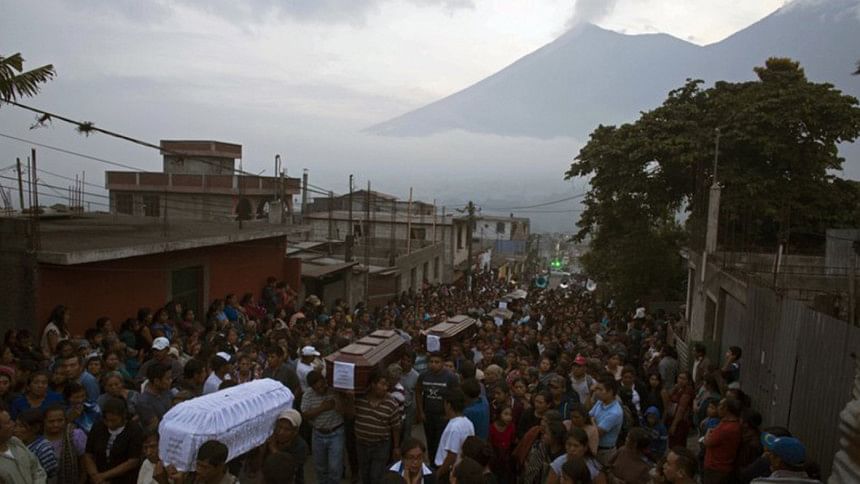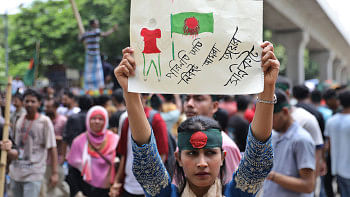Guatemala searches for volcano missing

People of the villages skirting Guatemala’s Volcano of Fire began mourning the few dead who could be identified after an eruption killed dozens by engulfing them in floods of searing ash and mud.
Mourners cried over caskets lined up in a row in the main park of San Juan Alotenango on Monday evening before rescuers stopped their work for another night.
There is no electricity in the hardest hit areas of Los Lotes and El Rodeo, so most searching continued only until sunset.
Guatemalan authorities put the death toll at 69, but officials said just 17 had been identified so far because the intense heat of the volcanic debris flows left most bodies unrecognizable.
“It is very difficult for us to identify them because some of the dead lost their features or their fingerprints” from the red-hot flows, said Fanuel Garcia, director of the National Institute of Forensic Sciences. “We are going to have to resort to other methods ... and if possible take DNA samples to identify them.”
Sunday’s eruption caught residents of remote mountain hamlets off guard, with little or no time to flee to safety.
Using shovels and backhoes, emergency workers dug through the debris and mud, perilous labor on smoldering terrain still hot enough to melt shoe soles a day after the volcano exploded in a hail of ash, smoke and molten rock.
Rescuers using heavy machinery and shovels found the bodies of more victims of an eruption at Guatemala’s Volcano of Fire. Crews also pulled 10 people still alive from the ash drifts and mud flows.
Bodies were so thickly coated with ash that they looked like statues. Rescuers used sledgehammers to break through the roofs of houses buried in debris up to their rooflines to check for anyone trapped inside.
Hilda Lopez said her mother and sister were still missing after the slurry of hot gas, ash and rock roared into her village of San Miguel Los Lotes, just below the mountain’s flanks.
“We were at a party, celebrating the birth of a baby, when one of the neighbors shouted at us to come out and see the lava that was coming,” the distraught woman said. “We didn’t believe it, and when we went out the hot mud was already coming down the street.”
“My mother was stuck there, she couldn’t get out,” said Lopez, weeping and holding her face in her hands.
Her husband, Joel Gonzalez, said his father had also been unable to escape and was believed to be “buried back there, at the house.”
Conred spokesman David de Leon said the volcano first erupted around midday Sunday, billowing smoke and ash miles into the sky. Then around 2 p.m., came a new, more powerful explosion.
Soon, searing flows of lava, ash and rock mixed with water and debris were gushing down the volcano’s flanks, blocking roads and burning homes.
“It traveled much faster. It arrived in communities right when the evacuation alerts were being sent out,” de Leon said.
Authorities scrambled to issue an evacuation order. Some communities emptied out safely. But in places like Los Lotes and the village of El Rodeo, about eight miles (12 kilometers) downslope from the crater, it was too late for many.
The fast-moving flows overtook people in homes and streets with temperatures reaching as high as 1,300 degrees Fahrenheit (700 Celsius), and hot ash and volcanic gases that can cause rapid asphyxiation.
“As soon as we received the information around 6 a.m. that the volcano was in an eruptive phase, the protocol was initiated to verify with different sectors and also talk to the communities, to community leaders,” De Leon said. “We had the information from our scientific service, and they told us the trend was that the activity was diminishing.”
In El Rodeo on Monday, heavily armed soldiers wearing blue masks to avoid breathing in ash stood guard behind yellow tape cordoning off the disaster scene. Helmeted workers carried bodies away on stretchers, and smoke was still rising from some parts of the ashen landscape strewn with boulders and other debris.
President Jimmy Morales traveled to survey the disaster area.
Emergency crews in helicopters managed to pull at least 10 people alive from areas cut off by the flows. Conred said 3,271 people had been evacuated.

 For all latest news, follow The Daily Star's Google News channel.
For all latest news, follow The Daily Star's Google News channel. 



Comments